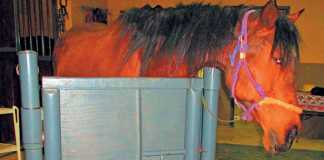In spring, especially after the first rain soaks the veld and leaks down into holes in the ground, snakes come out of hibernation.
If it’s still cold at night, they’re often attracted by the warmth of horse stables and inclined to “cuddle up” to sleeping horses.
As the horse gets up, it disturbs the snake and the most common bite is on the inside of the hind leg, between the hock and the stifle.
Venom damage
Snake venom comes from modified salivary glands, stored in hollow sacs in the head of the snake and injected into the victim through hollow fangs. There are two types of venom – neurotoxic and haemotoxic.
Cobras and mambas have neurotoxic venom that’s fast-acting and can cause nervous signs, shock and respiratory failure. The dose isn’t enough to kill an adult horse, but it can be lethal to a small foal.
Cytotoxic venom is typically found in puff adders and spitting cobras such as the rinkhals, Mozambican and ring-necked spitting cobras. Spitting cobras can also rapidly eject their venom into a horse’s eyes.
If this happens in the pasture, a panicked, partially-blinded horse can run into fences or tear its face open trying to rub the venom out of its eyes.
What snake?
Probably the most common bite is from the night adder, a small snake with a wedge-shaped head and diamond pattern along its back, which is often attracted to stables by rats. Bites are often seen on the legs and horses are bitten at night in the stables. In the morning, all that’s visible is a puffy swelling.
Within a few hours, the horse shows lameness in the affected limb. The bite wound is often only seen 24 to 48 hours later as two punctures, typically 1,5cm to 2cm apart in the middle of the swelling.
This differentiates the bite from that of the puff adder, where the bite wounds are characterised by a dribble of unclotted blood, and cobras, where the swelling is large and the marks are 2cm to 3cm apart.
Treatment
If venom gets into the eyes, wash repeatedly with water or a mild salt solution. If the horse is bitten on the face, there can be severe swelling and it may be necessary to put a short piece of hosepipe into each nostril to allow the horse to breathe.
General treatment consists of the administration of long-acting penicillin and vaccination against tetanus. Anti-inflammatories can be given by injection, as well as orally for about three to five days.
Cortisone can be given intravenously by a vet if neurotoxic venom is suspected. With many snakebites, you’ll see small, irregular haemorrhages on the membranes of the mouth and eyes.
With puff adder bites, the swelling is extensive and usually filled with dark or watery blood. After a few days, the skin becomes necrotic and falls off, leaving an ugly wound. Secondary infection can lead to death as a result of tetanus or gangrene.
Treatment
If venom gets into the eyes, wash repeatedly with water or a mild salt solution. If the horse is bitten on the face, there can be severe swelling and it may be necessary to put a short piece of hosepipe into each nostril to allow the horse to breathe.
General treatment consists of the administration of long-acting penicillin and vaccination against tetanus. Anti-inflammatories can be given by injection, as well as orally for about three to five days. Cortisone can be given intravenously by a vet if neurotoxic venom is suspected. Anti-venom is extremely expensive and difficult to obtain. It should only be given by a vet, as it can result in a fatal anaphylactic shock.
Anti-venom covers several different snakes including puff adder, mamba, rinkhals and cobra, but not the boomslang and night adder. If the bite is high up on the limb, the leg should be bandaged from the knee, or hock, to the hoof, as the venom can leak down and cause severe swelling in the coronet band.
Where the skin sloughs off, the bite is treated as an open wound. It can be washed with salt water, covered with paraffin gauze, and lightly bandaged.
Email Dr Mac c/o Chris Nel at [email protected]













